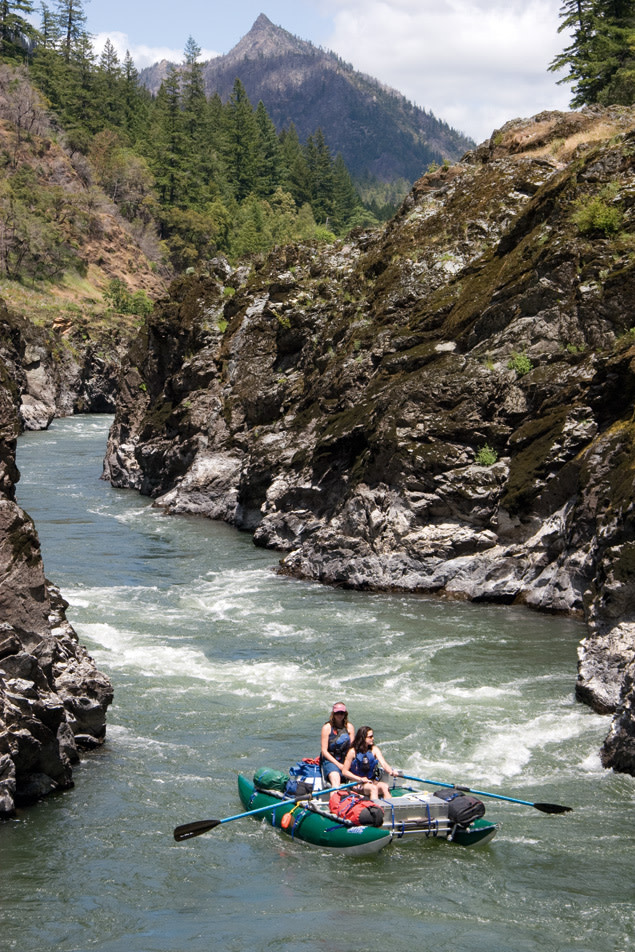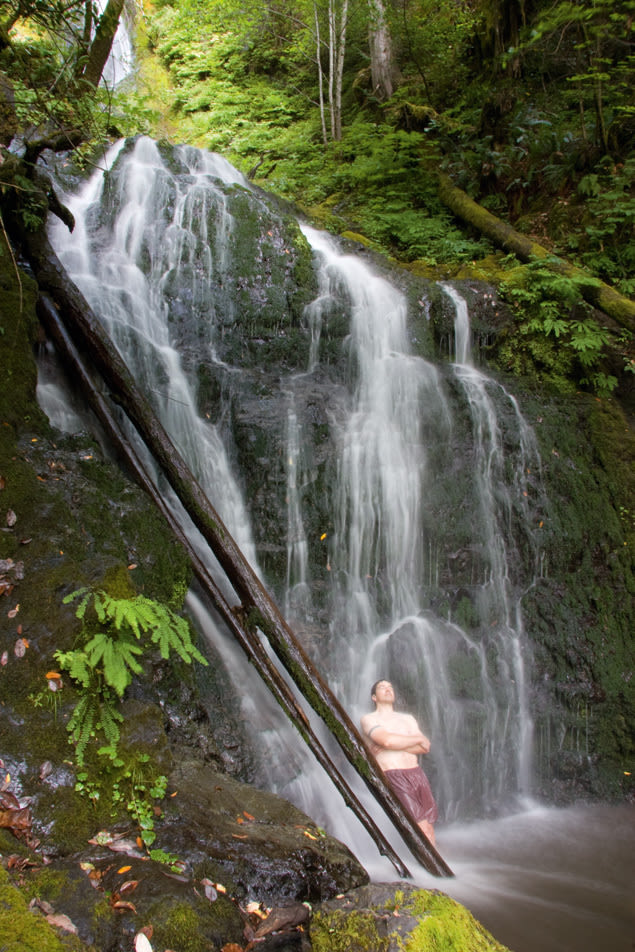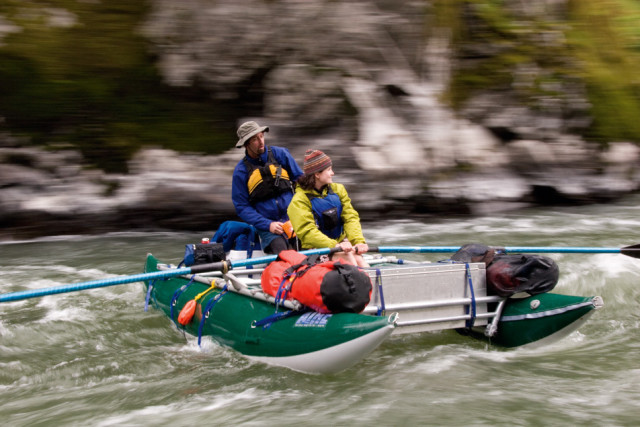Rogue Spirit

Image: Matt Leidecker
UNLESS YOU’RE AN extremely talented—and extremely warm-blooded—paddler, rafting the Rogue River this month would be a very bad idea. Come April, the 215-mile river surges with winter snowmelt rushing down from the Cascade and Coast Ranges; early spring rains only heighten the river’s rage. But if you want to paddle the Rogue this summer, when the rapids have mellowed into doable Class III (in June) or even Class II (in October), now is the time to make a reservation: The Rogue is one of the country’s most popular rivers to run, and outfitters that offer multi-day rafting trips are often booked to capacity by May.
The many accolades that are bestowed on the Rogue are due in part to its protected status: Forty years ago, the feds named the 84-mile stretch between Grants Pass and Gold Beach a National Wild and Scenic River, a designation that prohibits development within a quarter mile of its banks. As a result, the Rogue’s frothing rapids and undulating bends course through a landscape that is largely untouched. Other than a few cabins and lodges that were built decades ago, you can float for days without glimpsing evidence of modern civilization.
But there’s also the drama of the landscape itself. Some of Oregon’s most impressive geography is inevitably tough to access, and the only way to experience this section of river, which straddles Josephine and Curry Counties and cuts a path through the Wild Rogue Wilderness, is by boat or via a multi-day trek along the Rogue River Trail.
The payoff, however, is entirely worth the effort. When you’re deep inside the Rogue’s narrow canyon corridors—surveying the blue-gray sandstone on one side of the river and dark, lichen-speckled rock along the other bank—you’ll feel like you’re not just moving along the surface of the earth, but plunging into it. Where the river widens, sandy gravel bars make ideal picnic spots, while short hikes lead to lush, tucked-away waterfalls or the rusted-out remains of mining camps, such as the Whiskey Creek Cabin, built in 1880 and still filled with old tools and tin cans.
This is precisely the kind of rugged, mythically far-flung setting that beckoned me west from New England 11 years ago. Yet, despite the fact that the Rogue is just four hours by car from Portland, I’d never bothered to paddle it—both because I lacked the gear and wherewithal to do it myself and because I’ve never been partial to guided trips. Call me shy, antisocial, misanthropic or some combination thereof, but the idea of running a river with a flotilla of perfect strangers sounded perfectly awful to me. Out of 20 people on a group excursion, there’s bound to be one bad seed—a whiner, a loudmouth, a know-it-all or, heaven forbid, an evangelist. And the way I see it, one is all it takes to spoil an otherwise idyllic experience completely.

Image: Matt Leidecker
So went my thinking before my friend Matt Leidecker, an outdoors photographer who happens to be writing a Rogue River rafting guidebook, convinced me to accompany him on a trip last July. Matt has been a river guide on Idaho’s Middle Fork of the Salmon River for more than a decade, and my assessment of rivergoing people, he informed me, was entirely off the mark. "The vast majority of those who sign up for river trips are exactly the kind of folks you want to hang out with," he said assuringly.
These are not, he pointed out, women schlepping their curling irons or men who talk ad nauseum about the stock market. They are people who want to spend their few vacation days in the wilderness, nature lovers with limited time on their hands.
And so I finally relented and joined him on a four-day journey with Hood River-based Echo River Trips, a family-focused outfitter with 35 years of Rogue River experience. And, yes, as hard as this is to admit, I now know that the problem lies not with the curmudgeons of my imagination—but with the curmudgeon inside of me.
Consider Vicky, a middle-aged mother from Berkeley, California, who, together with her husband and two children, were among the 20 guests. The first days of the trip, traveling through the sculpted river valley, she was content to be a passenger on a large raft steered by one of the guides. But on the final day, she decided to face her trepidation and tackle the white water in a one-person inflatable kayak known as a "duckie." Paddling full steam into the crashing waves of the Tacoma Rapids, she dug her oars into the cresting rolls of water, navigating the right-to-left run with aplomb. So moved was I by her transformation that before even thinking about it, I let out an unguarded "Way to go, Vicky!"
It was during an afternoon meal of Thai peanut salad, fruit and sugar cookies that I first recognized yet another perk of guided trips. Outfitter tours are such thorough affairs these days that no detail is forgotten, not bug spray or margarita mix or backup tent stakes; not croutons or even a Frisbee (an excellent way to pass the time ashore). Instead of dealing with gear, prepping meals, washing dishes or plotting the next day’s campsite, guests can leave all that and more to the guides, and stay focused on the business of relaxing.
Rarely did we paddle for more than a couple of hours before pulling ashore, allowing us a chance to stretch kayak-cramped legs, lean back in the sand and look for wildlife, which is abundant on the Rogue. During our trip, we saw bald eagles, deer, river otters, ospreys and even a young black bear, loping along the south side of the riverbank.
On the third day, Matt and I pulled away from the group to scamper up a small but precariously steep ridge so he could snap some photos looking back upriver toward the Blossom Bar rapid, among the hairiest sections of the river. So narrow was the peak’s pinnacle that to take in the view of the river snaking through a canyon, I had to brace myself on a downed tree with one foot and grip the branch of a young manzanita with my right hand; I looked down just in time to see the first raft and a pod of duckies rounding a C-curve in the river. Even from a few hundred feet up, I recognized these people: the father-son pair from Sebastopol, California; the San Diego lawyer and his daughter; the guy from Milwaukee who works in publishing; the young San Francisco couple; the ever-enthused guides; and Vicky and her family. There were no bad apples here. It was official: My pre-Rogue attitude about outfitter tours was completely ridiculous.

Image: Matt Leidecker
On the final night, we feasted on fajitas and margaritas (known in some circles as "riveritas"). Our camping chairs arranged in a large circle, we begin sharing favorite moments of the journey, not just the most thrilling rapids—like Coffee Pot, where whirlpools of water surge between vertical cliff walls—but also moments that sealed friendships. Like the pickup game of ultimate Frisbee; evening silliness that included toenail painting courtesy of a river guide armed with fluorescent polish; and that first chilly mile of gentle floating downstream, as the sun burned away the fog that lurked just above surrounding hillsides, letting us know that a warm day was on the way.
On the last day of our trip, Vicky and I shared a kayak. After we aced a set of rapids, we turned our boat around in the river so that she could watch her daughters. Her oldest, just 13, deftly navigated a stretch of white water in a single kayak, followed by a double duckie powered by her husband in back and her younger daughter up front. As we maneuvered our craft toward the pullout at Foster Bar and the awaiting van bound for Galice, where we’d part, Vicky said, "I wish it wasn’t over." Her sentimentality unnerved me for an instant, before I noticed that I was already nodding in agreement. Me, too.




